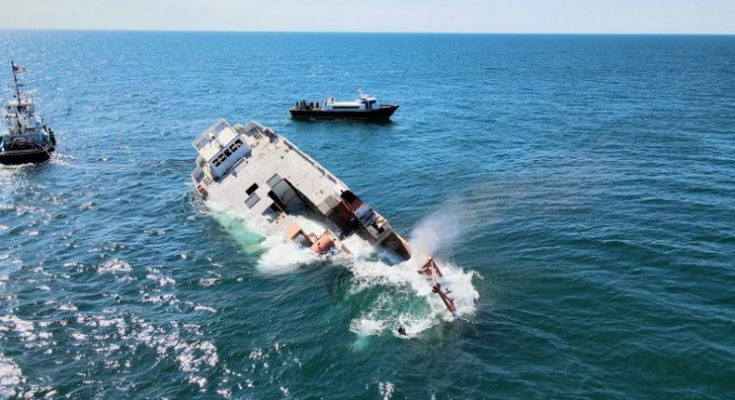The Department of Natural Resources and Environmental Control continued to broaden the recreational appeal of Delaware’s renowned artificial reef system by sinking the Texas Star, originally outfitted as a floating casino, at a reef site 16.5 miles offshore of the Delaware coast, with readings of 38.40.494/74.43.868 at a depth of 86 feet. Built in 1977 on a multi-purpose supply ship hull, the Texas Star was last at sea as a commercial scallop catcher/processor vessel, finding its third life at approximately 4:20 p.m. EDT Wednesday, June 29 as ocean floor fish habitat planned by DNREC’s artificial reef program.
The sinking of the 180-foot long Texas Star – as can be seen on the DNREC YouTube Channel – marked the reef program’s third deployment of a vessel in the last three years. The retired menhaden ship John S. Dempster Jr. was sunk on the Del-Jersey-Land Reef 26 miles off Indian River Inlet in early 2021, while a former Navy and later Army freighter and supply ship renamed Reedville when it too became a menhaden ship, was sunk onto Reef Site No. 11, known as Redbird Reef, in August 2020. All of them went down after the nationally-publicized 2018 sinking of the retired Lewes-Cape May, N.J. ferry Twin Capes onto the Del-Jersey-Land Reef, second only to Reef Site No. 11 as a popular recreational fishing destination.
“With today’s sinking of the Texas Star on Redbird Reef, one of 14 separate reef sites in the Delaware Bay and along the Atlantic Coast, we continue to enhance and expand the recreational fishing and diving experience in Delaware,” said DNREC Secretary Shawn M. Garvin. “When we sank Twin Capes four years ago as a centerpiece of Delaware’s artificial reef system, it was unmatched, providing fish habitat and a spectacular dive with its five decks for underwater exploration. Now anglers, the fish they are pursuing, and divers all will have another new destination.”
The Texas Star’s sinking was carried out by Norfolk, Va.-based marine contractor Coleen Marine, which has handled numerous reef deployments over the DNREC reef program’s existence at many of Delaware’s 14 permitted artificial reef sites. As with all the ships that DNREC sent down earlier, Texas Star was sunk only after receiving approvals from the U.S. Environmental Protection Agency and U.S. Coast Guard for environmental cleanliness and safety. The DNREC Division of Fish and Wildlife, which oversees the reef program, invested $325,000 in federal Sport Fish Restoration funds to buy the Texas Star from Coleen Marine after the ship settled onto the Redbird Reef.
As the newest addition to Delaware’s artificial reef program, the Texas Star joins the Dempster, the Reedville, Shearwater, Gregory S. Poole and Atlantic Mist as former commercial fishing ships now residing on Delaware artificial reef sites. Shearwater, Poole and Atlantic Mist, which also saw service as military vessels, are all part of the Del-Jersey-Land Reef, so called because it is roughly equidistant from ports of departure in each of the three states the reef’s name entails.
The Reedville was the first fishing vessel to be placed on Redbird Reef, so known because much of its structure consists of 714 retired New York City “Redbird” subway cars. Covering 1.3 square miles of ocean floor, other Redbird Reef structures include a 215-foot-long Chesapeake Bay cruise ship, 86 tanks and armored vehicles, eight tugboats, a fishing trawler and two barges.
Also residing on Delaware’s artificial reefs is the longest ship ever reefed on the East Coast, the 585-foot destroyer ex-USS Arthur W. Radford, which was sunk in 2011 on Del-Jersey-Land Reef. The reefs are also home to more than 1,350 retired New York City subway cars that have helped comprise the reef system over the last two decades, including the site where Texas Star was sunk.
Source: DNREC

